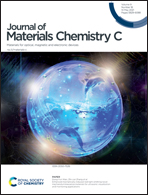Highly efficient and low efficiency roll-off organic light-emitting diodes with double-exciplex forming co-hosts†
Abstract
The single-exciplex system has been extensively used for constructing efficient organic light-emitting diodes. In this work, double-exciplex forming co-hosts are employed as the hosts of the phosphorescent materials in the quadruple-doped emitting layers (EMLs). Compared to the single-exciplex forming co-host, two discrete energy transfer channels are formed in the emitters with multiple energy transfer processes leading to successful enhancement of exciton utilization. As a result, the maximum external quantum efficiency (EQE) of the blue phosphorescent organic light emitting diode (ph-OLED) based on the double-exciplex host emitter is 1.25 times higher than that of the control device with the single-exciplex host. More importantly, the efficiency roll-off is significantly improved. Based on this strategy, white ph-OLEDs are also fabricated which exhibit outstanding properties with a maximum EQE of 21.26%; the EQE remained at 20.61% and 19.02% at a high luminance of 1000 cd m−2 and 5000 cd m−2, respectively. This work provides a universal design concept of exciplex based OLEDs to reach superior performance.



 Please wait while we load your content...
Please wait while we load your content...